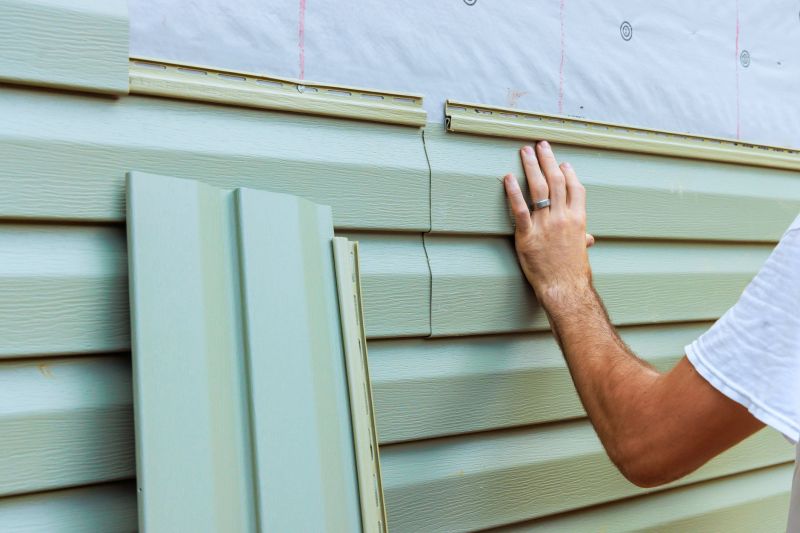Expert Picks for Vinyl Siding Panel Replacement Materials and Accessories
Choose from top-rated products that ensure a perfect fit and reliable performance during your siding upgrade.
 Replacing damaged or aging vinyl siding panels is an essential part of maintaining the appearance and integrity of a building's exterior. Selecting the right products for siding panel replacements can help ensure a seamless repair that blends well with existing siding. When considering replacement options, it's important to evaluate the compatibility of materials, ease of installation, and durability to achieve a satisfactory outcome. Modern siding replacement products come in a variety of styles, textures, and sizes, allowing homeowners and contractors to find suitable matches for different siding types and aesthetic preferences.
Replacing damaged or aging vinyl siding panels is an essential part of maintaining the appearance and integrity of a building's exterior. Selecting the right products for siding panel replacements can help ensure a seamless repair that blends well with existing siding. When considering replacement options, it's important to evaluate the compatibility of materials, ease of installation, and durability to achieve a satisfactory outcome. Modern siding replacement products come in a variety of styles, textures, and sizes, allowing homeowners and contractors to find suitable matches for different siding types and aesthetic preferences.
Top Overall Option
Vinyl Siding Panel
A versatile vinyl siding panel designed for easy installation and compatibility with existing siding. It offers a range of textures and profiles to match various styles, providing a seamless repair solution. Constructed from durable materials, it resists fading and cracking, making it suitable for long-term use in different weather conditions.
Types of Products For Vinyl Siding Panel Replacements
Vinyl Siding Panels
Standard vinyl panels available in various textures and profiles to match existing siding.
Insulated Vinyl Siding
Panels with added foam insulation for improved energy efficiency and soundproofing.
Beaded Vinyl Siding
Panels featuring a beaded profile that adds decorative detail to exterior facades.
Shingle Style Vinyl Siding
Panels designed to mimic traditional shingle siding for a classic look.
Board and Batten Vinyl Siding
Vertical panels with contrasting battens for a rustic or modern appearance.
Dutch Lap Vinyl Siding
Panels with a traditional lap profile that creates a shadow line for added depth.
Vertical Vinyl Siding
Long, narrow panels installed vertically for a distinctive aesthetic.
Textured Vinyl Siding
Panels with embossed textures that mimic wood grain or other materials.
Ribbed Vinyl Siding
Panels featuring pronounced ribs for a bold, modern look.
Premium Vinyl Siding
High-grade panels with enhanced durability and color retention.
Reversible Vinyl Siding
Panels with different textures or colors on each side for versatile styling.
Corner Posts and Trim
Complementary pieces to finish siding edges and corners seamlessly.
Siding Repair Kits
Complete kits including panels, fasteners, and tools for small repairs.
Panel Replacement Clips
Specialized clips to secure panels during installation or replacement.
Adhesives and Sealants
Products designed to bond panels and seal joints against moisture.
Popular Choices
Widely used for residential siding repairs, available in many styles and textures.
Popular for energy-conscious renovations, offering added insulation benefits.
Chosen for decorative accents and vintage-inspired exteriors.
Favored for its traditional aesthetic and weather resistance.
Selected for a distinctive vertical appearance and modern appeal.
Often used for historic or cottage-style homes.
Popular for its realistic wood grain or stone-like textures.
Valued for its versatility in styling options.
Essential for clean, finished edges in siding projects.
Convenient for quick fixes and ensuring secure installation.
Chosen for their durability and color stability over time.
Popular for modern, bold exterior designs.
Commonly selected for traditional home facades.
Increasing in popularity for contemporary architectural styles.
Frequently used to ensure weather-tight seals during installation.
Properly chosen replacement panels can improve the overall look of a property while also providing protection against weather elements. It's advisable to measure the damaged area accurately and select panels that match the existing siding's profile and color. Additionally, considering the ease of installation can save time and effort, especially for DIY projects. Many products are designed with user-friendly features, such as interlocking edges or snap-on mechanisms, making the replacement process more straightforward.
Maintenance considerations are also important when selecting siding replacement products. Materials that resist fading, cracking, and warping tend to require less upkeep over time. Some panels are manufactured with enhanced durability to withstand exposure to sunlight and moisture, ensuring long-lasting performance. Consulting product specifications and reviews can help identify options that meet specific needs, whether for a small repair or a large siding overhaul. Ultimately, choosing the right replacement panels can help restore the aesthetic appeal and functionality of a building's exterior efficiently and effectively.
Key Buying Considerations
- Compatibility with existing siding profile and color to ensure uniform appearance.
- Material durability and resistance to cracking, fading, and warping over time.
- Ease of installation, especially if undertaking DIY repairs.
- Availability of matching accessories such as corner posts, trims, and fasteners.
- Weather resistance features suitable for your climate conditions.
- Thickness and profile of the panels for proper fit and aesthetic consistency.
- Color options and whether they are fade-resistant or require special coatings.
- Maintenance requirements and long-term upkeep considerations.
- Manufacturer reputation and product reviews for reliability insights.
- Cost-effectiveness relative to the scope of your siding repair or replacement.
- Compatibility with insulation options if energy efficiency is a priority.
- Warranty coverage and support services offered by the manufacturer.
- Environmental factors such as exposure to sunlight and moisture that impact material choice.
- Availability of tools and accessories needed for installation or repair.
- Local building codes or homeowner association guidelines that may influence product selection.
